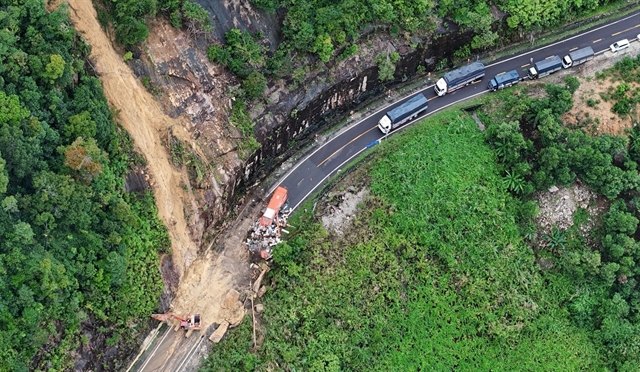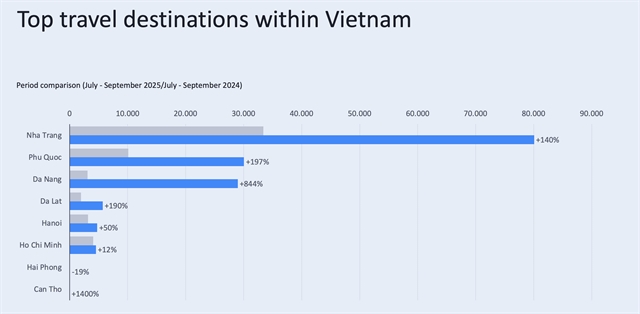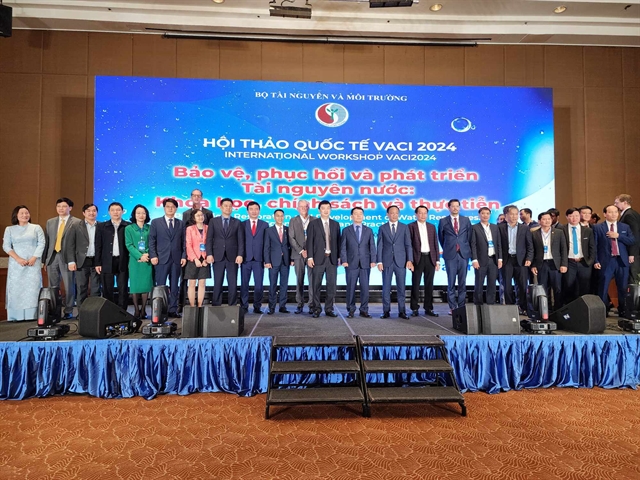 Environment
Environment


|
| Extinguished guests take a photo at the workshop. — VNS Photo Lê Việt Dũng |
HÀ NỘI — Climate change, sea level rise, saltwater intrusion and unsustainable water use fuel the water scarcity risks in Việt Nam.
That was the remark made by Tống Ngọc Thanh, director general of the National Centre for Water Resources Planning and Investigation (NAWAPI), at the workshop "Protection, Restoration and Development of Water Resources: Science, Policy and Practice" on Friday.
To deal with the situation, Việt Nam has enacted the revised Law on Water Resources 2023 to change the way the country manages its water resources, improving the efficiency of water use and curbing water pollution.
"Under the law, water resources will be considered as a public property owned by the people, and the State will be the representative of the owners," said Thanh.
Nguyễn Chí Nghĩa, director of the Northern Division for Water Resources Planning and Investigation, underlined the pollution problems in many rivers in big cities in Việt Nam.
He attributed the problems to urbanisation, which prevents rainwater from infiltrating the ground and makes it run into drainage systems where it mixes with wastewater and flows into the water bodies.
He highlighted other countries' solutions to the problems. The countries have built permeable structures and artificial underground water-replenishing systems to facilitate water infiltration.
They have also built treatment plants to process rainwater caught in drainage systems before discharging it into the environment. The solutions have proved highly effective in reducing water pollution.
The director suggested a four-step measure to restore the polluted rivers. The first step involves identifying the causes of river degeneration in big cities. The next is to set restoration objectives.
Performers then develop a restoration plan based on the objectives, which, he believes, will work best with the involvement of all stakeholders and relevant parties.
Anke Steinel, senior BGR hydrogeologist at CRMGG Project, said the Mekong Delta faces several water resources challenges.
The first challenge involves the increase in surface water salinity, which is caused by tidal effects reaching further inland due to sand mining and the change in discharge pattern due to dam construction.
Another challenge is climate change, which impacts indirectly on groundwater demand and directly on surface water.
"In the last decade, groundwater abstractions have increased significantly, with an annual increase of 17 per cent between 2011 and 2015," said Anke Steinel.
She cited the two Managed Aquifer Recharge pilots in the project as climate-resilient solutions for the Mekong Delta. Their potential recharge could reach 15,000 cubic metres per month, with the capital costs for Pilot 1 being at EUR$30,000.
Felix Dörr, expert in land subsidence from Postdam University, said the subsidence observatory installed by his team in Cà Mau Province found that the causes of land subsidence could be the dynamics of the groundwater level and precipitation changes.
Within a depth of between zero to 13m, a land subsidence of 0.7mm was observed between December 2022 and April 2023. The team also saw a little subsidence between 35 and 84m, and even more happening below.
"From December to April, we had an average of 0.8mm per month of subsidence," said Felix Dörr. — VNS